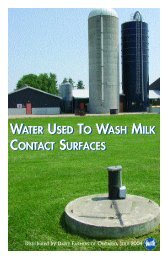Canadian Quality Milk On-Farm Food Safety Program - Centre ...
Canadian Quality Milk On-Farm Food Safety Program - Centre ...
Canadian Quality Milk On-Farm Food Safety Program - Centre ...
You also want an ePaper? Increase the reach of your titles
YUMPU automatically turns print PDFs into web optimized ePapers that Google loves.
<strong>Canadian</strong> <strong>Quality</strong> <strong>Milk</strong><br />
You also must record whenever a problem occurs regarding pre-rinse/wash water<br />
temperature and what corrective action was taken to remedy the situation. A sample<br />
form is in the Workbook (Record 13).<br />
7.1.4 Post-<strong>Milk</strong>ing Cleaning SOPs<br />
To ensure that milk is cooling properly and that the equipment is cleaned adequately, a<br />
post-milking cleaning SOP is an important part of your CQM program. Write your own<br />
SOP using the Workbook (Record 4) or your own variation. The SOP must contain<br />
enough information to ensure that a relief milker can set up the cleaning system.<br />
Describe step by step the various actions that must be taken to set-up the equipment for<br />
cleaning after milking.<br />
You should consider the following Best Management Practices when you develop your<br />
own SOP, but you must include the Best Management Practices that are shaded<br />
grey. This SOP should be accessible in the milk room.<br />
Check and record the milk temperature (after each milking) (this can be done<br />
automatically with some time temperature recorders).<br />
Check and record the cleanliness of milking equipment regularly (e.g. receiver jar<br />
and bulk milk tank) (minimum acceptable frequency is monthly, weekly is<br />
recommended).<br />
Check and record the temperature of the pre-rinse water (weekly) or wash water<br />
(monthly) (Record 13) (this can be done automatically with some time temperature<br />
recorders).<br />
Put the wash diverter valve into the “wash” position.<br />
Let air into the washline to empty the milkline.<br />
Clean the claws’ outer surfaces and set them in wash position.<br />
Empty the receiver.<br />
Clean the strip cup and teat dip cup.<br />
Move the milk transfer line from the bulk tank to the wash sink.<br />
Remove the milk filter, checking for milk clots and unusual dirt.<br />
Replace milk filter with a clean one if the milking system has a plate cooler.<br />
Add detergent (if using a manual system).<br />
Flick the wash panel switch to the “wash” position.<br />
Clean the milk house floor.<br />
Close the doors between the milk house and the barn (self-closing doors are<br />
recommended).<br />
7—8<br />
June 2010
















